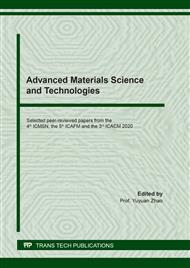[1]
Edward J. Calabrese, PhD*, and Gaurav Dhawan, MPH. How radiotherapy Was Historically used to treat Pneumonia: could it Be useful today?. YALE JOURNAL OF BIOLOGY AND MEDICINE 86 (2013), pp.555-570.
Google Scholar
[2]
Linlin Zhang. X-ray Structure of Main Protease of the Novel Coronavirus SARS-CoV-2 Enables Design of a-Ketoamide Inhibitors. bioRxiv preprint doi: https: //doi.org /10.1101 /2020.02.17.952879.
DOI: 10.37473/dac/10.1101/2020.02.17.952879
Google Scholar
[3]
Geoffrey J Gorse et al. Human Coronavirus and Acute Respiratory Illness in Older Adults with Chronic Obstructive Pulmonary Disease The Journal of Infectious Diseases 2009; 199:847–57.
DOI: 10.1086/597122
Google Scholar
[4]
Jiménez, E.; Recalde, N.; Chacón, E.J. Extraction of the Proton and Electron Radii from Characteristic Atomic Lines and Entropy Principles. Entropy 2017, 19: 293.
DOI: 10.3390/e19070293
Google Scholar
[5]
Jimenez, E.J. Algorithms of the Femtoscope: KeV X-Rays Cure Cancer While MeV X-Rays Only Burn the Cells. American Journal of Computational Mathematics, 8, 1-17.
DOI: 10.4236/ajcm.2018.84023
Google Scholar
[6]
Zheng Liu. Structure determination of a human virus by the combination of cryo-EM and X-ray crystallography. Biophys Rep 2016, 2(2–4):55–68.
Google Scholar
[7]
Gerard Kian-Meng Goh et al. Understanding Viral Transmission Behavior via Protein Intrinsic Disorder Prediction: Corona viruses. Hindawi Publishing Corporation Journal of Pathogens. Volume 2012, Article ID 738590, 13 pages.
Google Scholar
[8]
Kaufhold, S.; Kaufhold, A.; Jahn, R.; et al. A new massive deposit of allophane raw material in Ecuador. Clays Clay Miner 2009, 57: 72–81.
DOI: 10.1346/ccmn.2009.0570107
Google Scholar
[9]
Particle Technology Labs. Available online: https://www.particletechlabs.com/?matchtype =b&network=g&device=c&keyword=%2Bparticle%20%2Btechnology&campaign=188869210&adgroup=14931061570&gclid=EAIaIQobChMIpqG126-L5wIVy56zCh1LGQqXEAAYASAAEgKfvvD_BwE (accessed on Monday July 2018).
Google Scholar
[10]
Kaufhold, S.; Dorhmann, Z.; Abidin, Z., et al. Allophane compared with other sorbent minerals for the removal of fluoride from water with particular focus on a mineable Ecuadorian Allophane. Appl Clay Sci 2010, 50: 25–33.
DOI: 10.1016/j.clay.2010.06.018
Google Scholar
[11]
Kaufhold, S.; Ufer, K.; Kaufhold, A.; et al. Quantification of allophane from Ecuador. Clays Clay Miner 2010, 58: 707–716.
DOI: 10.1346/ccmn.2010.0580509
Google Scholar
[12]
Perego, G. Characterization of heterogeneous catalysts by X-ray diffraction techniques. Catalysis Today 1998, 41: 251-259.
DOI: 10.1016/s0920-5861(98)00054-6
Google Scholar
[13]
Humphrles, A.; Hrris, D.H.; O'connor, P. The nature of active sites in zeolites: Influence on catalyst perfomance. In Fluid Catalytic Cracking: Science and Technology, 1st ed.; Magee, J.S., Mitchell, M.M., Eds.; Elsiever Science Publishers B.V: Amsterdan, the Netherlands, 1993; Volume 76, p.41–82.
DOI: 10.1016/s0167-2991(08)63825-2
Google Scholar
[14]
Adams, M. Fundamentos de química de suelos., Primera Ed.; Ediciones Anauco: Caracas, Venezuela, 1995; Volumen 1, pp.316-325.
Google Scholar
[15]
Kaufhold, S.; Ufer, K.; Kaufhold, A.; et al. Quantification of allophane from Ecuador. Clays Clay Miner 2010 58: 707–716.
DOI: 10.1346/ccmn.2010.0580509
Google Scholar
[16]
Hidalgo, C.; Etchevers, J.; Quantin, P. Imologita en un andisol de México. Turrialba 1991, 41(4): 509-514.
Google Scholar
[17]
ASTM D-4294. Standard Test Method for Sulfur in Petroleum and Petroleum Products by Energy Dispersive X-ray Fluorescence Spectrometry.
DOI: 10.1520/d4294-08ae01
Google Scholar
[18]
Jiménez, E.; Paucar, A.; Herrera, P. Study of the catalytic activity of the faujasite from natural clinker and pumice. Phys Chem Indian J 2017, 12: 1–16.
Google Scholar
[19]
Avidan, A. Origin, development and scope of FCC catalysts. In Fluid Catalytic Cracking: Science and Technology, 1st ed.; Magee, J.S., Mitchell, M.M., Eds.; Elsevier Science Publishers B.V: Amsterdan, the Netherlands, 1993; Volume 76, p.1–39.
DOI: 10.1016/s0167-2991(08)63824-0
Google Scholar
[20]
Jiménez Calderón, E.H.; Paucar Tipantuña, A.E.; Herrera Mullo, P.F.; Hidalgo Cháfuel, D.A.; Ruiz, W.; Stahl, U.; Bermudez, J. Natural and Activated Allophane Catalytic Activity Based on the Microactivity Test in Astm Norm 3907/D3907M-2019. Appl. Sci. 2020, 10, 3035.
DOI: 10.3390/app10093035
Google Scholar


